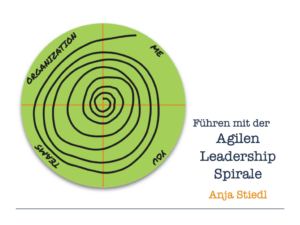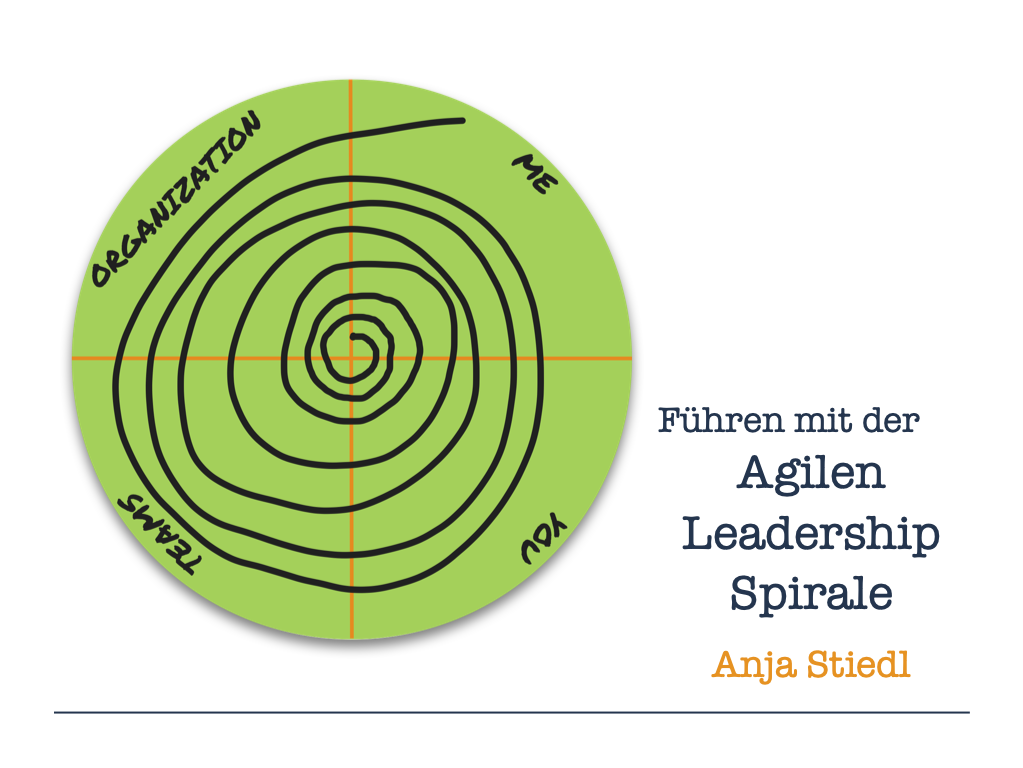Agil führen mit der Agile Leadership Spirale
So wie jedes andere Reise zur persönlichen Meisterschaft ist auch die Reise auf dem Weg zu Agiler Führung unendlich, stets herausfordernd, immer zur Reflexion und zur Verbesserung anregend.
Für uns ist die Arbeitsweise und Wirksamkeit einer Agilen Führungskraft visualisiert in einer Spirale, die in vier Segmente unterteilt ist: ME, YOU, TEAMS und die ORGANIZATION, stellvertretend für die Reflexion an mir selbst, Kontakt mit dem Gegenüber, die Arbeit mit Teams und an der Organisation. Diese vier Themen werden in ihrer Anwendung immer wieder tangiert, bearbeitet und bereichert mit mit neuen Sichtweisen, Erfahrungen, Einsichten, Erkenntnissen und Zielen. In diesem Text geben wir einen Überblick über die vier Segmente:
ME – Starte bei dir selbst!
Du startest jede Reise zu Agiler Führung bei dir selbst. Auf den ersten Blick mag dies egozentrisch erscheinen, doch so ist es nicht gemeint. Ganz und gar nicht.
Sei Stark
Um anderen am besten dienen zu können, musst du selbst in bester Verfassung sein. Du musst stabil und stark sein, zuverlässig und voller Ressourcen. Darum musst du bei dir selbst starten!
Kenne deinen Sinn und dein Ziel
Im Zusammenhang mit Sinnfindung und Sinngebung für andere musst du deinen eigenen Sinn und dein eigenes Ziel mit dem Sinn und Zweck des Kontextes, der Umgebung und der Organisation in Verbindung setzen. Also: kenne deinen eigenen Sinn und dein Ziel!
Kläre deinen Erfolg
Um überhaupt erfolgreich sein zu können, musst du dir im Klaren sein, was Erfolg eigentlich für dich bedeutet. Definiere ihn und messe dich daran.
Definiere deine Intention!
Du kannst nur dort erfolgreich sein, wo du dies beabsichtigst und du deinen inneren Motivationen und Treibern folgst. Werde dir selbst bewußt, dass du dich auf der Reise befindest und sie weiter begehen willst. Sage deutlich JA.
Sei ein Vorbild
Als Führungskraft wird erwartet, dass du eine Vorbild-Funktion einnimmst. Arbeite an dir selbst und sei darauf gefasst, dass jemand folgen könnte, der sich von dir führen läßt!
Lehre andere
Willst du andere etwas authentisch lehren, so kann es nur das sein, was du selbst erlebt hast, was du selbst voll und ganz an- und aufgenommen hast!
Beziehungen: du und ich
Im Modell der Agile Leadership Spirale verlassen wir nun die Sicht nach innen und wenden uns anderen Menschen zu und unserer Verbindung zu ihnen. Wir starten bei einer Person.
Klein und doch schon komplex
Du erkennst, dass die kleinste Form von Beziehungen zwischen Menschen diejenige ist, die lediglich zwei Menschen umfaßt. Und auch dieses sind bereits zwei komplexe Systeme, die miteinander agieren. Du erkennst, dass der Aufbau der Beziehung zu einem anderen Menschen, die Führung und Erhaltung der Beziehung eine sehr herausfordernde Aufgabe ist, wenn sie ernst genommen und verfolgt wird, mit dem Ziel des Erfolges.
1-zu-1 Beziehungen
Es macht keinen Unterschied, wie groß die Organisation ist, in der du bist, und wieviele Menschen du führst: letztendlich sind Führungs-Beziehungen immer 1-zu-1-Beziehungen. Und alle komplexeren Strukturen von Teams oder Teams von Teams lassen sich zurückführen auf 1-zu-1-Beziehungen.
Führung in zwei Richtungen
Zudem verläuft jede Führungsbeziehung in zwei Richtungen: nicht nur führst du die andere Person, gleichzeitig führt die andere Person auch dich. Wie verändert dieser Gedanke deine Perspektive?
Auf Augenhöhe
Wenn du Agile Werte und Prinzipien glaubst und anwendest, siehst du, dass alle Menschen sehr wertvoll sind und du baust deine Beziehungen auf Respekt und Mut auf. Es ergeben sich engere Beziehungen, während andere lockerer sind. Es gibt Menschen, mit denen du gerne sprichst und mit denen du dich gerne umgibst, während es andere gibt, mit denen du den Kontakt als Herausforderung empfindest. Dennoch schätzt du deine Verbindungen und du strebst an, Beziehungen auf Augenhöhe zu führen.
Setze deine Grenzen
Trotzdem gibt es Situationen, in denen du deine Grenzen und Beschränkungen deutlich machen und klären musst, um dich so sicher zu fühlen wie du es benötigst.
Teams: zusammen stark!
Wir leben und arbeiten in einer komplexen Welt, wir leben in der VUCA Welt. Wir vermuten mal, du kennst bereits diese Abkürzung für volatile, uncertain, complex und ambiguous. (Ansonsten findest du im Internet auch sehr viel darüber.) Die beste Art zu gedeihen und erfolgreich zu sein führt über die Zusammenarbeit in autonomen, funktionsübergreifenden Teams, die klein genug sind, damit sie flink agieren können, und doch so groß, dass sie signifikante Erfolge in kurzen Zeitabschnitten erzielen können. Wir brauchen Teams, um gemeinsam stärker zu sein.
Zusammenarbeit
Du musst lernen mit anderen zusammenzuarbeiten, um erfolgreich zu sein, du musst andere lehren zusammenzuarbeiten, damit dein Team florieren kann, damit dein Team über sich hinaus wachsen kann. Dazu gehören Kommunikationsfähigkeiten, Klarheit zu Strategien und Ermächtigung von Team-Entscheidungen, Ansätze um Feedback zu geben oder Konflikte anzugehen.
Autonomie und Ausrichtung
Damit die Zusammenarbeit des Teams in die gewünschte Richtung läuft, musst du ein einheitliches Verständnis und gemeinsame Ausrichtung zu Team-Vision und Team-Zielen generieren und kommunizieren. In Zusammenhang dazu stehen die Motivation aller, die Möglichkeit, dass alle Stimmen, Ideen und Bedenken gehört werden sowie die Einladung an alle, sich aktiv zu beteiligen.
Unter der Oberfläche
Heutzutage hat jeder schon mal über das Eisberg-Modell gehört und das damit verbundene Bild, dass viel mehr los ist unter der Oberfläche des Ozeans als man von oben erahnen kann. In Teams sind dies die Team-Dynamiken: alle suchen nach den Orten, in die sie reinpassen, wie wir am besten mit den andern in Beziehung treten und uns verbinden, wie wir gemeinsam etwas erreichen und wie wir unser Leben im Team großartig für alle gestalten. Als Agile Führungskraft musst du dir über diese Dynamiken bewusst sein, sie erkennen, mit ihnen und an ihnen arbeiten, versagen, wieder aufstehen und wieder probieren, wieder und wieder.
Das Ich im Wir finden
Um sich voll und ganz auf ein Team einzulassen, muss jeder Mensch auf seine eigenen individuellen Ziele klären, mit den Teamzielen in Verbindung bringen und sie einpassen. Du hilfst Menschen, diese beiden Aspekte zu erforschen, klären und an beiden zu arbeiten.
Organisationen: den Wandel führen
Die meisten Organisationen finden sich in großen Transformationen, um alle Menschen mit dem Produkt großartig zu machen, die Kunden und die Benutzer besser zu bedienen durch Produkte, die sie lieben, um auf die schnellen und überraschenden Veränderungen in ihren Märkten zu reagieren und um mit Innovationen der Zukunft zu begegnen.
Strukturen
“Structure eats Culture for Lunch.“ (Wer hat dies zuerst gesagt?)
Kümmere dich um die Strukturen und beginne die organisatorische Veränderung bei den Strukturen. Was auch immer du erzielen willst, wenn die Umgebung noch nicht bereit ist dafür und sich der Veränderung widersetzt, wird sich nichts tiefergehend verändern und die Initiative wird langfristig versagen.
Kultur
“Culture follows structure.” (Craig Larmans Gesetz über Verhalten von Organisationen)
Damit kommt die Kultur als nächstes! Der Wandel wird nicht nachhaltig sein, wenn die Kultur der Organisation sich nicht entsprechend ändert. Fokussiere darauf. Arbeite daran. Lebe es: als Individuum und in deinem Team!
Führung
Organisationen ändern sich nicht von alleine. Organisationen brauchen Führung, Wandel braucht Führung. Welche Führungsstile passen zu dir im Kontext und der Kultur der neuen Organisation? Welchen Führungsstil braucht die Organisation von dir?
Führungs-Teams
Du kannst den Wandel nicht alleine durchführen. Kläre deine Verbündeten und bauen ein Team auf, das den Change in deiner Organisation führt und antreibt. Füllt eure Rollen als Vorbilder aus, einzeln und auch als Team!
Mut
Unser Lieblingswert. Die Verantwortung Agiler Führung anzunehmen wird deinen Mut erfordern. Und es wird dir noch mehr Mut zurückgeben. Sei stets darauf gefaßt, überrascht zu werden!
Wiederholung!
Zurück zum Bild der Spirale: diese Reise ist nie vorbei und jede weitere Herausforderung, die du annimmst, wird dich wieder durch dieselben Themen begleiten, mit einem neuen Startpunkt und dem Schatz all deines Wissens und deiner Erfahrungen. Du wird deine Fähigkeiten in den nächsten Abschnitt deiner Reise bringen und auf ihnen aufbauen, um sie in einem neuen Kontext zu verwenden und auszubauen.
Und jetzt?
Bist du neugierig geworden, wie du die Agile Leadership Spirale nutzen kannst, um mit Agilität zu führen? Möchtest du konkrete Techniken kennenlernen, um dich selbst, deinen Agilen Leadership-Style zu reflektieren und zu verbessern? Willst du deine Mitarbeiter und Kollegen erfolgreich agil führen? Brauchst du Methoden, um Agile Teams erfolgreich aufzusetzen und zu begleiten? Willst du mehr erfahren, wie du durch die Agile Transformation in der Organisation führen kannst?
Diese und weitere Themen findest du in unserem Training:
>>>AGILE PEOPLE DEVELOPMENT – führe Menschen zu mehr Agile Leadership!<<<
Nächster Termin: 20./21. Januar 2022 9:00-17:00 CET, online
>>>LEADING WITH AGILITY – mit Agilität führen!<<<
Nächster Termin: 28./29. April 2022 9:00-17:00 CET, online
Infos, Details und Termine hier: Agile Leadership Trainings

